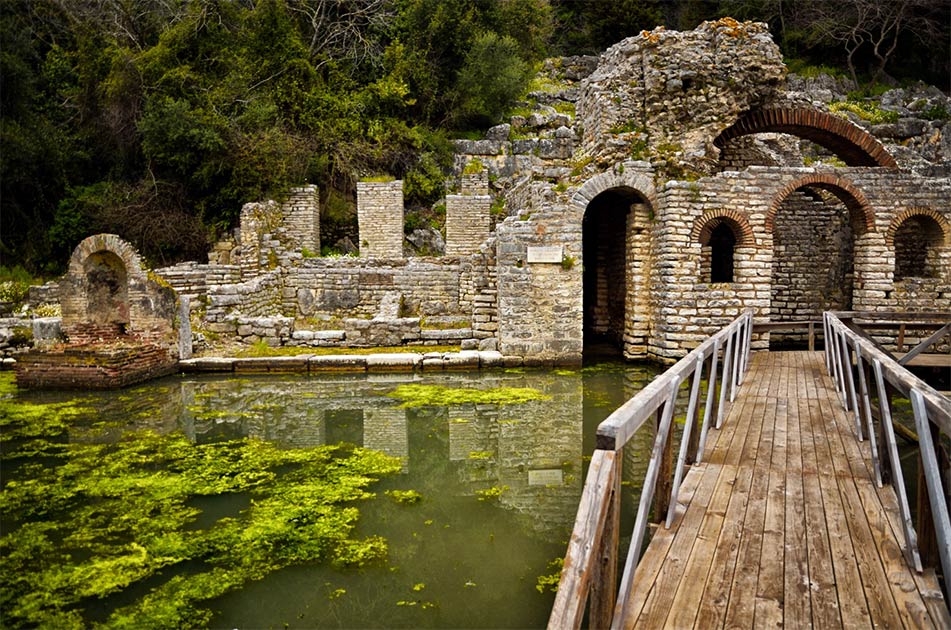Butrint National Park, Preserving the Rise and Fall of an Ancient City
Albania was once part of the Greek, Roman, Byzantine, and Ottoman worlds and as a result has a rich archaeological legacy. One of the most important archaeological sites in the Balkan country is Butrint National Park, protecting the remains of a long-abandoned city. This site, once known as the city of Buthrōtum, offers us a unique window into the past. Such is its historic importance that it was designated a UNESCO World Heritage site in 1992.
The History of Butrint National Park: War and Trade
The first settlement at Butrint was by an Illyrian tribe and by at least the 8th century BC, Greeks had founded a city at the location. According to legend it was established by a Trojan refugee, although this claim is highly unlikely.
The Greeks build an acropolis on an eminence and their new city became a significant trading hub because of its strategic location in what is now southern Albania. The city was prosperous thanks to trading with Balkan tribes.
By the 5th century BC, the city was conquered by the Greeks of Corfu, who expanded the city. In the 3rd century BC, along with Corfu, it became a protectorate of Rome and greatly benefitted from trade with the Republic. The city was later annexed and became part of the Roman Empire after the Macedonian Wars.

Statue of Asklepios found on the island of Kos, Greece (Alterfalter / Adobe Stock)
Under Roman rule, the city continued to prosper and became a major center of the Cult of Asklepios. It was part of the Eastern Roman or Byzantine Empire and its economy went from strength to strength.
During the 7th century, the history of Butrint becomes unclear and it is not known if it was controlled by the Byzantines or the Slavs. By the 9th century the Byzantines once again definitely controlled the city and they rebuilt much of it. The Byzantines contested control of Butrint with first the Normans from southern Italy and later the Angevins.
The once prosperous city began to decline in importance and became little more than a small town. When marshes formed in the area, Butrint was eventually abandoned. The site was never re-occupied because of the persistent conflict between the Venetians and the Ottoman Turks.
Butrint was first excavated in the 1920s but was later neglected by the Albanian Communist regime. In the 1990s, the site was deemed to be at risk from looters. Since 2002 the former city has been a designated national park.
The Wonders of Butrint, Albania
The Park is located on a peninsula of the straits of Corfu. Perhaps the best-known attraction at Butrint is its Roman-era theatre. This semi-circular structure surrounds a central stage. The ruins of the proscenium or stage area can be seen along with the walls and entrances of the original structure.
- Christian Symbols Hidden in Ancient Pagan Mosaics of Butrint Baptistery
- A Dream Cure? The Effective Healing Power of Dream Incubation in Ancient Greece
- Vandals Smash Monumental Fountain in Ancient Greek City of Apollonia

Roman theatre in Butrint, Albania (dudlajzov / Adobe Stock)
Near the theatre is the Temple of Asclepius dedicated to the Greek god of healing and where the sick would go to be healed. There are a number of Graeco-Roman shrines in the park, including an altar to Dionysus, the god of wine and intoxication. Also to be found are the ruins of the thermae, the central heating system.
The forum or central public space of Roman-era Butrint can still be visited but it is now mostly only stones. The remains of a gymnasium, however, are still extensive. An aqueduct that once supplied water to the citizens, is now crumbling but it once the lifeblood of the town.

View of the Ali Pasha Castle across the waters (jkraft5 / Adobe Stock)
On a hill overlooking the site are a number of ruins which once formed part of the acropolis. Above the Classical remains are the ruins of a 16 th century Venetian church. The magnificent walls of the 6th-century Christian basilica built by the Byzantines exhibit some of the original mosaics and they still have the power to amaze.
The monumental lions gate features a symbol of a lion killing a bull, which was possibly the symbol of Buthrōtum. Near the site, the Ali Pasha Castle lies within a small island along with the mouth of the Vivari Channel. The castle is named after the Albanian ruler Ali Pasha who was one of the most feared pirates in the Adriatic.
Visiting Butrint National Park in Albania
The park is located in southern Albania and there are regular buses from the nearby city of Saranda to the Park. It is also possible to book tours to the city from the popular holiday island of Corfu. and guided tours are available.
Top image: Walkway into the ruins of Butrint, Albania's major archaeological center. Source: Marta P. (Milacroft) / Adobe Stock
By Ed Whelan
References
Bego, F., & Malltezi, J. (2011). Ecotourism opportunities and challenges in Butrint, Albania, a Unique UNESCO and Ramsar site. Journal of Coastal Research, (61), 150-157
Hansen, I. L., Hodges, R., & Leppard, S. (Eds.). (2013). Butrint 4: The archaeology and histories of an Ionian town (Vol. 4). Oxbow Books
Hodges, R. (2013). E xcavating away the ‘poison’: the topographic history of Butrint, ancient Buthrotum. Butrint, 4, 1-21
Available at: https://d1wqtxts1xzle7.cloudfront.net/60157399/18._Hernandez_ABSA_11220190730-56472-1u1e1js.pdf?1564480329=&response-content



















